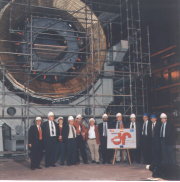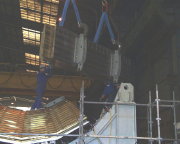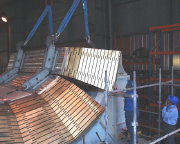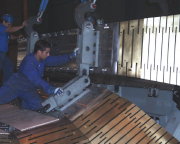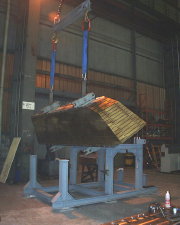|
Design of the CMS Wedge Lifting Fixture
Bartoszek Engineering worked closely with the design group at Fermilab for the Compact Muon Solenoid Hadron Barrel Calorimeter. BE was hired to do final engineering on the concept created by the CMS engineers to manipulate the 40 ton wedges of the Hadron Barrel Calorimeter. The concept of using brackets on the wedges as lifting points and pivots to rotate the wedges into place was a very creative one, but the main drawback to the initial concept was that the lift slings and hardware would interfere with the wedge during rotation of the wedges. BE's contribution was to design the curved lifting fixture brackets that allowed the rotation to occur without interference or damage to the side of the wedges.
The design was done entirely to European drafting standards and the parts were manufactured in Spain. The main engineering issues were coming up with a design that satisfied the under-the-hook lifting fixture codes, and choosing materials and heat treatment processes that could achieve the necessary strength required by the codes.
These pictures show the test assembly of the barrel at the factory in Spain where it was produced. Once it is installed at CERN, pans of plastic scintillator tiles with wave shifter and light guide fibers are installed into the slots in the brass absorber. The combination of alternating layers of active radiation detectors and passive radiation absorbing material produces a sampling calorimeter that can measure the energy of the collisions in the CERN Large Hadron Collider (LHC).
Click on any of the thumbnails to get an enlarged view. You are welcome to download any of the images. If they are used for other than private viewing, credit to Bartoszek Engineering would be appreciated.
This is a group photo in front of the completed absorber of the barrel calorimeter. I believe it was taken at the factory in Spain where the wedges were produced, after the test assembly of the wedges to make sure they fit together before shipment to CERN. The calorimeter is a beautiful and large piece of work intended to be installed at the CMS detector hall at CERN in the Large Hadron Collider.
This picture shows how the wedges are lifted from the factory floor and manually positioned for attachment to the barrel calorimeter.
The brackets bolted to the wedges served the dual purpose of providing a place to attach the lifting slings, and providing a pivot point to allow each wedge to be installed at its correct angle.
This is a close-up of how the pivoting mechanism works. Once the pins are engaged that allows the upper wedge to rotate freely about a fixed axis, the spreader bar is lowered causing the wedge to rotate into place.
This is a different arrangement that shows how a wedge produced in one orientation can be lifted and rotated to a different orientation. One reason to do this is that wedges assembled to the bottom of the calorimeter are installed with their small end up. Once the assembly reaches the mid-plane of the detector, the wedges get installed with their small ends pointing down. This photo shows the spreader beam that BE also designed.
Back to the Bartoszek Engineering Projects Page
Back to the Bartoszek Engineering Home Page
|
